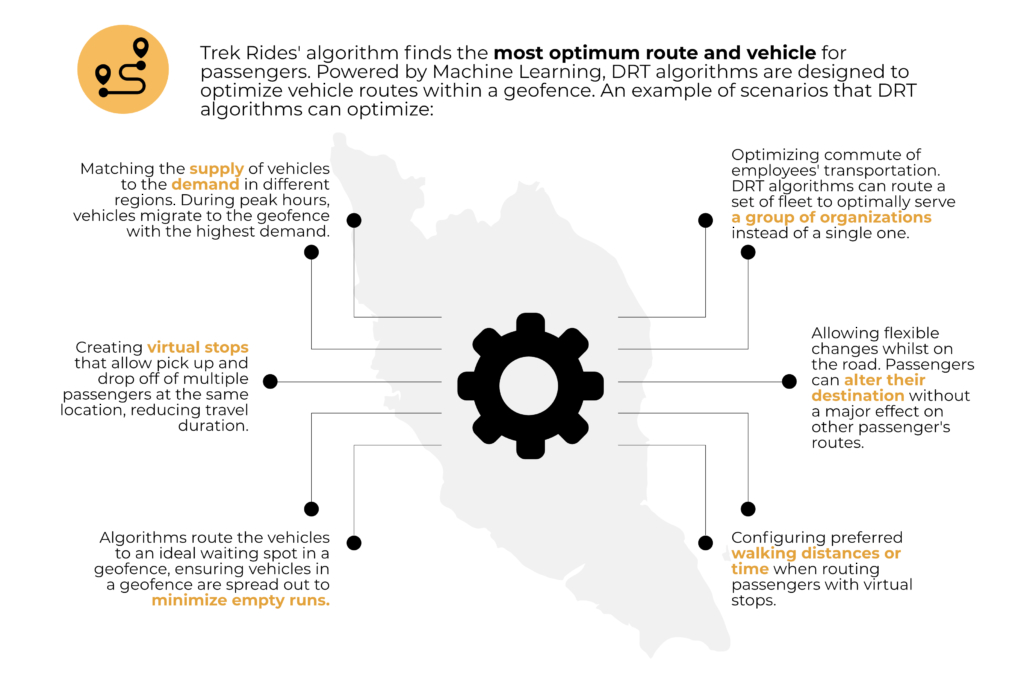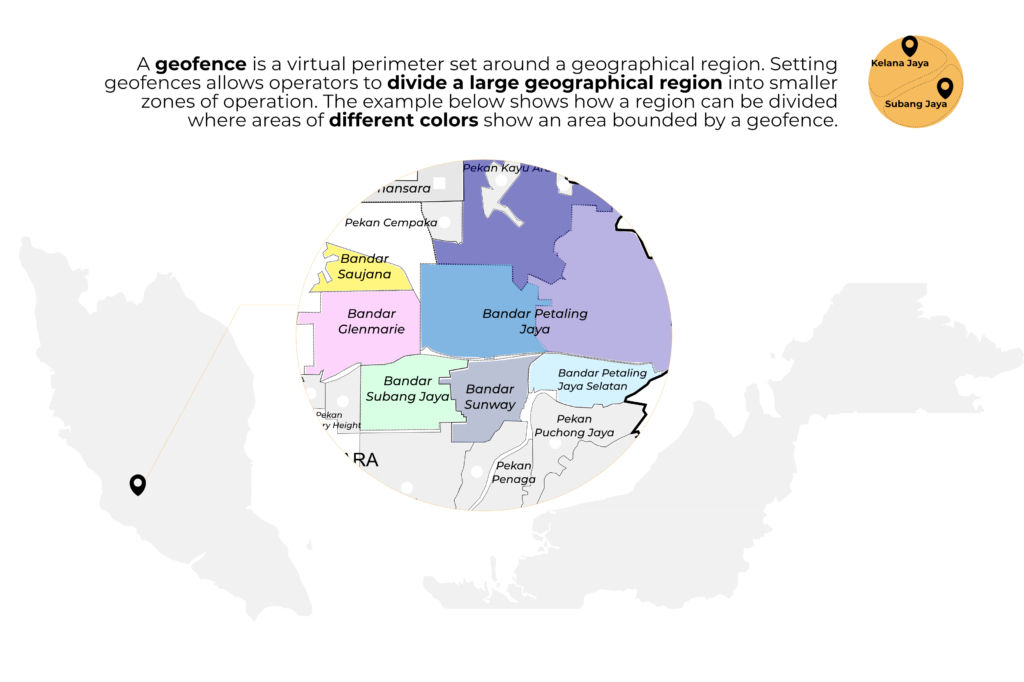Come follow Nabil as he journeys through a DRT service
In our last article, we explored the concept of Demand-Responsive Transit (DRT) and how it is different from shuttle and pooling as well as ride-hailing services.
We concluded that DRT is superior to other forms of services that do not have features such as intelligent routing and geofencing to create value for commuters.
Put simply, DRT is the best solution for the first-mile last-mile issue, and it is a key strategy to increase public transport ridership.
Today, we explore what a DRT service looks like and what a commuter would actually experience when using a DRT service
Some questions that come to mind include: Do I need to book the service in advance? Can I change my destination while I’m on the trip? Can friends join whilst on my trip?
A DRT experience
Meet Nabil, a 23 year old who works as a mechanical engineer. Nabil’s firm recently relocated to a new office in Bangsar South. The location is not parking-friendly so Nabil looks for an alternative way to commute to work that is convenient yet affordable.
Nabil lives near PJ Old Town, a 15 to 20 minute drive from work when roads are clear. He considered ride-hailing services but he found that using one everyday would be too expensive. The same goes for taxis.
He didn’t know of any colleagues going to Bangsar South so he couldn’t carpool and while there was an LRT service that could take him 80% of the way, the first-mile/last-mile connectivity was poor — meaning he struggled to get to and from the LRT to complete his journey.
His friend, Ravinder, who stays in Bandar Sunway, recommended that he use the new DRT service in Petaling Jaya. At first, Nabil had no idea what DRT is, but after some research and reading, he found the concept of DRT to be a brilliant alternative for his commute to work and decided to give it a try
Here is how his journey went.
Booking & Payment
After spending just five minutes downloading the app and signing up for the DRT service on his smartphone, Nabil searches for a vehicle to pick him up from PJ Old Town and get him to his office
DRT services can vary in design where some provide a door-to-door service while others create virtual stops at a maximum of one to two minutes walk from a location. Nabil’s service was door-to-door service.
He made a booking and paid a very affordable fee that is slightly higher than a bus fare but considerably lower than a ride hailing service. He was notified by the app to be ready as his vehicle will arrive in three minutes.

The Ride
The vehicle was a mid-capacity shuttle van driven by a professional driver. After five minutes of commuting, Nabil was surprised to see the van stop to pick up his friend Mei, who lived in PJ New Town. She is an avid user of the DRT service and was on her way to KL Gateway Mall, which is located about one kilometre before Bangsar South.
How did Mei end up in the same van as Nabil?
DRT services are powered by intelligent machine learning algorithms that generate routes in real-time, which tell the van driver the best route to take given the traffic conditions and the location of others who have signed up for the ride. This ensures passengers do not waste time when commuting.
DRT services also run within geofences. These are virtual fences that limit where a van can operate in a given area so that the DRT service provider will know exactly where all its vans are at any one time. By utilising the intelligent algorithms and the concept of geofencing, the right van is sent to pick up other passengers that may be on its route before reaching its final destination.

This is how Nabil’s van driver was told to pick Mei up as her pick up point in PJ New Town came after Nabil’s at PJ Old Town. Before reaching Nabil’s office at Bangsar South, the van will drop Mei off at KL Gateway mall, as it comes before Bangsar South.
Nabil’s DRT van knew to pick him up first before picking Mei up in the same vehicle, as both headed in the same direction, and not to pick up Ravinder, who lives out of the way in Bandar Sunway.

Change of mind
While on his ride to work, Nabil realised he would arrive at the office much earlier than he anticipated. As such, he decided to have breakfast.
Nabil requested for a change in destination while on the van, selecting a favourite mamak shop three minutes walk away from his office. Within seconds, the driver diverted to this shop and Nabil alighted and went for breakfast.
This is another plus point for DRT services. They are flexible enough to accommodate changes in real-time as their routing engines rely on computationally efficient and automated machine learning algorithms and not on manual, predetermined ways to plan a route.
This same learning algorithm makes it easy for Nabil to make real-time changes that are flexible enough to change without affecting the other passengers on the same route.
Final words
Nabil enjoyed his trip as he got to socialise with Mei on his trip , and spent an affordable sum to get to office and even got to change his plans midway during his trip.
There is no doubt a DRT service has its advantages over ride-hailing, car-pooling and shuttle services. It’s affordable, flexible, easy-to-use, and convenient for any commuter, making DRT Services the wave of the future.
For more information on DRT Services, check out our previous post. To find out more about our solutions, contact us here.
Share This Story!
RELATED POSTS
Come follow Nabil as he journeys through a DRT service
In our last article, we explored the concept of Demand-Responsive Transit (DRT) and how it is different from shuttle and pooling as well as ride-hailing services.
We concluded that DRT is superior to other forms of services that do not have features such as intelligent routing and geofencing to create value for commuters.
Put simply, DRT is the best solution for the first-mile last-mile issue, and it is a key strategy to increase public transport ridership.
Today, we explore what a DRT service looks like and what a commuter would actually experience when using a DRT service
Some questions that come to mind include: Do I need to book the service in advance? Can I change my destination while I’m on the trip? Can friends join whilst on my trip?
A DRT experience
Meet Nabil, a 23 year old who works as a mechanical engineer. Nabil’s firm recently relocated to a new office in Bangsar South. The location is not parking-friendly so Nabil looks for an alternative way to commute to work that is convenient yet affordable.
Nabil lives near PJ Old Town, a 15 to 20 minute drive from work when roads are clear. He considered ride-hailing services but he found that using one everyday would be too expensive. The same goes for taxis.
He didn’t know of any colleagues going to Bangsar South so he couldn’t carpool and while there was an LRT service that could take him 80% of the way, the first-mile/last-mile connectivity was poor — meaning he struggled to get to and from the LRT to complete his journey.
His friend, Ravinder, who stays in Bandar Sunway, recommended that he use the new DRT service in Petaling Jaya. At first, Nabil had no idea what DRT is, but after some research and reading, he found the concept of DRT to be a brilliant alternative for his commute to work and decided to give it a try
Here is how his journey went.
Booking & Payment
After spending just five minutes downloading the app and signing up for the DRT service on his smartphone, Nabil searches for a vehicle to pick him up from PJ Old Town and get him to his office
DRT services can vary in design where some provide a door-to-door service while others create virtual stops at a maximum of one to two minutes walk from a location. Nabil’s service was door-to-door service.
He made a booking and paid a very affordable fee that is slightly higher than a bus fare but considerably lower than a ride hailing service. He was notified by the app to be ready as his vehicle will arrive in three minutes.

The Ride
The vehicle was a mid-capacity shuttle van driven by a professional driver. After five minutes of commuting, Nabil was surprised to see the van stop to pick up his friend Mei, who lived in PJ New Town. She is an avid user of the DRT service and was on her way to KL Gateway Mall, which is located about one kilometre before Bangsar South.
How did Mei end up in the same van as Nabil?
DRT services are powered by intelligent machine learning algorithms that generate routes in real-time, which tell the van driver the best route to take given the traffic conditions and the location of others who have signed up for the ride. This ensures passengers do not waste time when commuting.
DRT services also run within geofences. These are virtual fences that limit where a van can operate in a given area so that the DRT service provider will know exactly where all its vans are at any one time. By utilising the intelligent algorithms and the concept of geofencing, the right van is sent to pick up other passengers that may be on its route before reaching its final destination.

This is how Nabil’s van driver was told to pick Mei up as her pick up point in PJ New Town came after Nabil’s at PJ Old Town. Before reaching Nabil’s office at Bangsar South, the van will drop Mei off at KL Gateway mall, as it comes before Bangsar South.
Nabil’s DRT van knew to pick him up first before picking Mei up in the same vehicle, as both headed in the same direction, and not to pick up Ravinder, who lives out of the way in Bandar Sunway.

Change of mind
While on his ride to work, Nabil realised he would arrive at the office much earlier than he anticipated. As such, he decided to have breakfast.
Nabil requested for a change in destination while on the van, selecting a favourite mamak shop three minutes walk away from his office. Within seconds, the driver diverted to this shop and Nabil alighted and went for breakfast.
This is another plus point for DRT services. They are flexible enough to accommodate changes in real-time as their routing engines rely on computationally efficient and automated machine learning algorithms and not on manual, predetermined ways to plan a route.
This same learning algorithm makes it easy for Nabil to make real-time changes that are flexible enough to change without affecting the other passengers on the same route.
Final words
Nabil enjoyed his trip as he got to socialise with Mei on his trip , and spent an affordable sum to get to office and even got to change his plans midway during his trip.
There is no doubt a DRT service has its advantages over ride-hailing, car-pooling and shuttle services. It’s affordable, flexible, easy-to-use, and convenient for any commuter, making DRT Services the wave of the future.
For more information on DRT Services, check out our previous post. To find out more about our solutions, contact us here.




